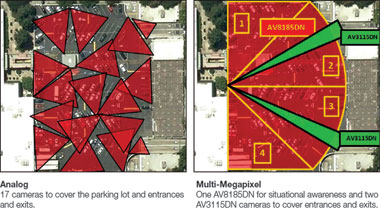

Megapixel cameras provide superior performance and imaging capabilities versus legacy analogue technology and standard-definition IP cameras. Megapixel cameras are also field-proven to deliver the most cost-effective video surveillance solutions.
To understand the real value of megapixel cameras, it is important to evaluate the total system cost, not simply the price of a single camera. Analogue and standard definition IP cameras may be priced less than megapixel cameras on a per camera basis, but they deliver significantly less value when total system costs are evaluated. Compared to the efficiencies of megapixel cameras, analogue and standard IP cameras do not provide a comparable return on investment (ROI). This white paper will analyse the additional value of megapixel cameras through a quantifiable measure of that value: pixels per dollar (Pp$).
Purchasing results, not cameras
When end-user customers buy cameras, what they want is the ability to view video that cost-effectively achieves the goals of an application. They need video that can deliver facial recognition and licence plate identification, captures numbers from shipping crates and shows activity in retail stores, bank branches, company or government facilities or at borders, airports or ports and more. They are purchasing the capabilities and functionality the cameras can provide to solve a specific problem.
Megapixel cameras do a far better job of capturing more information than standard-resolution cameras, and that superior performance translates into ROI in several ways. Based on the measurement of 'pixels per metre', a standard for the number of pixels required to depict one metre of a scene for a specific application, more pixels translate into a larger viewing area.
For example, while it could require 10 standard-resolution cameras to cover a single parking lot, the same coverage can be delivered using three or four three-megapixel cameras or even a single megapixel panoramic camera, depending on the application requirements.
This reduction in the number of cameras translates into a decrease in installation costs and maintenance costs. Furthermore, the ability to digitally zoom into live scenes and recorded video while maintaining high resolution and wide area coverage, virtually eliminates the need for mechanical pan-tilt zoom (PTZ) devices. By capturing a detailed, wide-angle view without the PTZ camera requirement of having a live operator following events in real-time, multi-megapixel cameras can also deliver reduced operating costs by eliminating operations staff.
Understanding resolution
A true advantage of megapixel cameras is the ability to provide more resolution than analogue or IP VGA cameras. Using estimated pricing and the number of pixels as a quantitative measure of resolution, it is easy to distinguish that megapixel cameras provide more resolution for the money.
The table illustrates the cost-effectiveness at various camera resolutions. VGA or standard definition cameras provide about 300 000 pixels per camera. Megapixel cameras provide 1 300 000 to 10 000 000 pixels per camera, or more.
This analysis demonstrates how the most cost-effective imaging solutions are multi-megapixel cameras. The VGA-resolution cameras provide 1536 pixels per US dollar ($), compared to 1080p cameras at 5891 pixels/dollar and 10 MP cameras at 18 438 pixels/dollar.
At 10 MP resolutions, multi-megapixel cameras are 10-times more cost-effective compared to VGA cameras. Understanding resolution makes it simple to evaluate which camera (or what number of cameras) will provide the most value for a given application. Pixels per metre specifies how many pixels are needed to effectively view a certain area.
Cost comparison: parking lot
System cost vs. camera cost
When crunching the numbers on a surveillance system installation, it is helpful to take a full view of total system costs. The total cost of the system is a more meaningful measure than the price of a single component.
In the case of megapixel cameras, beyond the relative lower resolution-per-dollar cost analysis, other savings include a decrease in absolute costs such as installation by using fewer cameras, the elimination of mechanical pan-tilt-zoom devices, a reduction in operations staff and support costs.
Using fewer cameras to effectively cover the same area also translates into infrastructure cost savings (cables, mounts, housings, etc.), which makes it easy to realise an improved ROI.
Multi-megapixel cameras deliver the highest image quality and ROI. Low-resolution analogue and VGA IP cameras provide significantly less value than multi-megapixel IP cameras.
For more information contact Arecont Vision, +1 818 937 0485, [email protected], www.arecontvision.com

© Technews Publishing (Pty) Ltd. | All Rights Reserved.